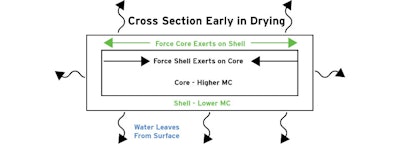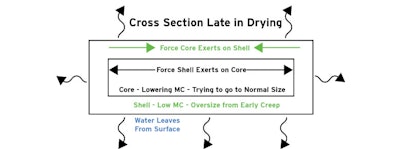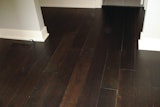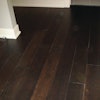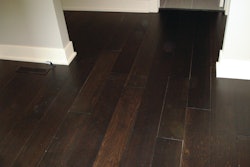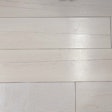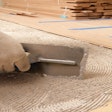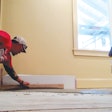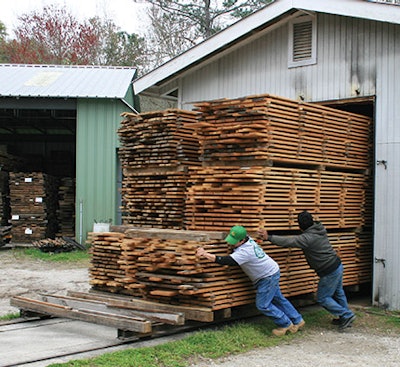
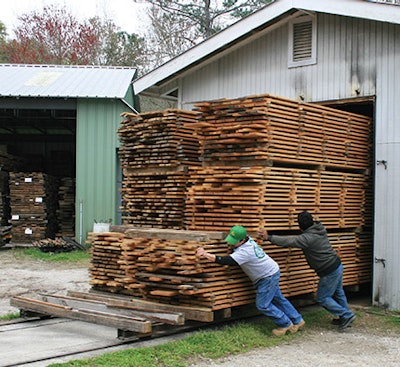 Photo courtesy Goodwin Heart Pine
Photo courtesy Goodwin Heart Pine
Have you ever opened a bundle of flooring only to find a board so crooked that it can't be used or another that is split in half lengthwise? What about boards of different widths or surface checks that appear after installation? Why do some pieces bind up on the rip saw blade? Although these problems can be looked at as grading issues, the underlying cause can sometimes be traced to the drying process. Kiln drying is one of the fundamental steps in the production of wood flooring. The drying process leaves a legacy in the wood that occasionally shows up when the flooring is put into service. This discussion is intended as an overview of the basic drying process for those who use wood flooring.
Drying Wood: Not a Simple Process
The fundamental concept is simple enough: The drying process removes water from wood to bring the moisture content (MC) to a level that optimizes the product's performance in use. This is necessary because, as we all know, wood changes size when the MC changes at values below the fiber saturation point (FSP). (For details on how wood reacts with moisture, see my article "Under the Microscope" in the August/September 2010 issue.) The MC in wood moves toward an equilibrium value dictated by the relative humidity of the surrounding air. Green wood contains a significant amount of water. Typically the MC of green oak is in the 65 percent to 80 percent range. The drying process for flooring reduces the MC to the 6 percent to 9 percent range. This can involve removing over 2,000 pounds of water from 1,000 board feet of lumber. In addition, high temperatures in the kiln can eliminate insects and help set the pitch in resinous species.
As with many other apparently simple procedures, in practice the drying process is complex and involves tradeoffs in factors including expense and quality.
As with many other apparently simple procedures, in practice the drying process is complex and involves tradeoffs in factors including expense and quality. The details of the drying process are best dealt with by combining knowledge, judgment, diligence and care. Energy costs, inventory turn time, utilization of the physical plant and wood degradation are all significant financial concerns. The goal is to take lumber that varies in density and initial MC and quickly produce a product with a specified uniform MC, both within each board and from board to board. This should be done without creating undue degradation such as checks (on the surface, on the ends or in the interior of the boards), discoloration, latent defects or excessive internal stress. Wood cut down 100 or 200 years ago retains its hygroscopic characteristic of taking on and losing moisture. It still shrinks and swells with changing relative humidity. In almost all cases, wood that is well air-dried has too much moisture for interior service, so flooring should be kiln-dried. This includes antique wood, as well.
The Drying Steps
Lumber is sorted before it is dried because it dries at different rates depending on the species, cut (quartersawn or flatsawn), thickness, density and resin content. Green lumber of the same species, length, cut and thickness is stacked in layers that are separated by stickers to form bundles of standard size. This separation between the layers allows air circulation through the stack. In wood, water moves most quickly in the longitudinal direction and most slowly in the tangential direction. Quartersawn boards dry more slowly than flatsawn boards. Thick lumber dries more slowly than thin lumber. Heartwood often dries more slowly than sapwood. At the stacking stage, lumber is typically coated on the ends to slow drying and reduce end-checks.
In the past, most lumber was air-dried for a period of weeks prior to going to the kiln. Sometimes pre-dryers were also used. Now green lumber is often sent directly to the kiln for faster turnaround and more control of drying conditions. Kilns typically control temperature, humidity and air flow. These parameters are changed in a series of steps called a schedule, which encompasses the active part of drying. Relative humidity, MC or simply time can determine the progress through the kiln schedule. Kilns typically employ electronic automation or computer control to proceed through the kiln schedule.
Equalization and conditioning steps, which achieve more uniform MC (between boards and within boards) and relieve some of the internal stress, typically complete the kiln process. At this juncture, some of the surface checks may close, although the damage to the wood fiber is not repaired. The term "latent checks" is used to indicate the possibility that checks may reappear.
Cooling and relaxation steps are common after what is referred to as the "charge" of lumber is removed from the kiln. A significant MC survey should be done to assess the MC level and variation within the load before the lumber is sent along. Wood dried on a traditional schedule retains its hygroscopic character. When the RH goes up, it takes on water and swells. A decrease in RH causes a loss of water and the associated shrinking. A 3 percent MC spread in 5-inch red oak flooring accounts for almost 1⁄16 inch variation in width. Flooring brought to higher than normal temperatures can show a reduction in the FSP, with reduced shrinking and swelling as the RH changes. This treatment also changes some of the other properties of the wood and can make the wood more prone to splits.
What Happens in the Kiln
There are different mechanisms used to dry wood; kiln types include steam, hot water, direct fired, dehumidification, solar, vacuum, immersion and microwave. As indicated previously, the most common type consists of an enclosure in which temperature, relative humidity and air flow can be controlled. Commercial dry kilns are commonly heated by steam or hot water that is produced in a separate boiler. Larger boilers can heat more than one kiln at the same time. Waste wood and natural gas are two of the most common fuels used to fire boilers for kilns. Energy from the steam or hot water is introduced into the chamber through heat exchangers. Large high-capacity fans circulate air through the heat exchangers and then through the entire stack. Often the fans are reversible in order to achieve more uniform drying in the charge.
The layers within the lumber stacks are separated by stickers, which are placed parallel to the air flow to allow circulation through the packs. Moisture is expelled by venting some of the air to the outside. If the humidity gets too low, water spray or steam is introduced into the kiln. Temperature is controlled by regulating the energy flow to the heat exchangers. Proper air circulation is achieved using baffling, stacking geometry and adjusting the fan speed. Large kilns typically reverse the air flow periodically to even out the drying of the opposite sides of the charge.
Temperatures of 140 to 190 degrees Fahrenheit are not uncommon in kilns; these temperatures and high humidity can make even a short visit to the inside of a kiln unpleasant. The traditional method of monitoring the drying process in a charge of lumber is to use sample boards. Selected short pieces placed in some of the packs are periodically weighed to determine their MC. This direct measurement MC avoids variability in MC readings introduced by the use of electronic meters.
Internal Stress in the Wood
In a dry kiln, boards lose moisture from the surface into the air. The result is the MC of the surface, or shell, decreases before the water from the core of the board can diffuse to the surface. If the core were not present (that is, if the boards were hollow) the shell would shrink once the MC dropped below FSP. When the core is present, it restrains the shell from shrinking. The shell is thus stretched, or creeps, and is larger than it would be at the current MC if the core were not there. If the forces exerted on the shell exceed the strength of the wood, checks form. Toward the end of the drying process, the forces reverse. The expanded shell is pulled together (compressed) by the core as it dries. At the end of the active drying process there will be internal forces in the board. The term for this is "case hardening." (The condition is not similar to case hardening in metals other than that both involve thermal treatment.) Case hardening in wood can be detected (see the "Case Hardening Explained" sidebar at right) and reversed by introducing moisture into the shell at the end of the kiln cycle.
If the board is cut along its length, the pieces can both curve significantly even though the original piece was straight. This can cause binding on a saw blade and a dangerous situation.
Boards that are partly juvenile wood, near the pith, also tend to dry with considerable internal stress. Unlike mature wood, juvenile wood shrinks appreciably in the longitudinal direction when it is dried. This can create substantial internal stress within a board that contains both types of wood and leads to crooked lumber. If the board is cut along its length, the pieces can both curve significantly even though the original piece was straight. This can cause binding on a saw blade and a dangerous situation. Compression wood from leaning conifers also shrinks faster than normal mature wood, and thus contributes to internal stress and can cause problems similar to juvenile wood.
The drying process can create problems for wood floor professionals. Some issues are concealed in the wood, while others are visible to graders and can be removed in the grading process. Lumber that was milled at the incorrect MC will shrink or swell to a different size when exposed to "normal" site conditions. If the MC spread was substantial within a batch, the wood flooring boards can vary noticeably in width, which makes a good installation impossible.
On the Job Site
When an installed wood floor is too wet, we can take a lesson from kiln operators to bring down the MC as quickly as possible. Even with precise control and optimum conditions, drying lumber in a kiln can take weeks. Outside the kiln we should utilize the same factors to dry floors. Higher temperatures, lower humidity and increased air flow are the best way to dry a floor as quickly as possible. Just as happens in the kiln, rushing wood on a job site before it's ready will only result in the problems down the road.
Case Hardening ExplainedNear the beginning of kiln drying, the MC of the outside shell decreases more than the core of the lumber. As the shell attempts to shrink due to reduced MC, the core opposes this movement. This causes the shell to stretch or creep. Fast drying at this point can cause surface checks.
Later in the drying process the now-oversized shell opposes the shrinking of the core as the interior MC decreases. If a fast drying rate generates forces greater than the strength of the wood, internal checks can form.
Residual internal stress between the shell and the core is called case hardening. If a narrow slice is cut into the shape of a tuning fork, the tines will curve inward if case hardening is present. Case hardening can be reversed or eliminated at the end of the kiln cycle.
|
For more articles by author Andrew St. James, see:
Wood Floor Cupping: Why Does it Happen & What Can You Do?
Understand the Science of Water and Wood Floors
Understanding How to Measure Moisture Can Avert Job-Site Disasters











